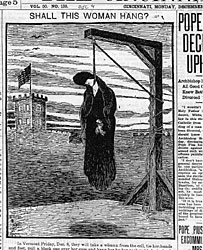
Saving Women from the Gallows How Social Movements Played a Role
In the 19th and early 20th centuries, the controversy surrounding women and the death penalty united two reform movements in organizing protests on the local, state and national levels, but did this partnership benefit their separate causes?
Annulla Linders, associate professor of sociology for the University of Cincinnati, examined three sensational trials that brought together the anti-gallows movement and the emerging womens rights movement. Her paper, titled, Acting in Concert or Concerts of Action: Challenges and Opportunities in the Campaigns Against Female Executions, 1895-1915, was presented on Aug. 13 at the 102nd annual meeting of the American Sociological Association in New York.
Linders says the research covers a period when the womens movement was crusading for suffrage, and both the womens movement and the movement against capital punishment were mobilizing throughout the nation. She adds that although many women faced the death penalty during that period, only seven were executed. Combing through newspaper data stored at the Library of Congress, Linders followed the campaigns uniting the womens movement and the anti-gallows movement around three distinct cases, two of them ending in executions
- 1899 Martha Place, 42, became the first U.S. woman to die in the electric chair when she was executed in New York. Place was convicted of using a pillow to suffocate her 17-year-old stepdaughter during an argument and attacking her husband (who survived) with an axe.
- 1905 Mary Rogers, 19 and a young mother, was executed in Vermont and was the subject of a newspaper anti-death penalty campaign that stretched to Cincinnati. She was hanged for killing her husband by drugging him with chloroform and, with the help of an accomplice, rolling his body into a river. Linders notes that one of the most prominent out-of-state efforts to save Rogers from the death penalty was generated by a petition drive from the Cincinnati Post, which produced 40,000 signatures over three days (and sent a female Post reporter to present the signatures to Vermonts governor). The New York Times also ran the news of a separate petition drive in Kentucky.
- 1913 Bessie Wakefield, 23, of Connecticut won a second trial and was sentenced in 1914 to life in prison. It was the mother-of-twos lover who was accused of shooting and stabbing her husband to death, but both had initially been sentenced to death. James Plew was hanged for the crime in 1914. Linders notes that Wakefields execution was also protested in Cincinnati by the Womans Christian Temperance Union, the Womans Club, the YMCA, the Womens Civic Commission and other groups.
Linders says that before the movements united to protest the executions of women, the two movements rarely joined forces. While not in opposition to each other, they were pursuing different goals. In these cases, Linders says the womens movement would argue that since women had no voice in creating laws, how can they be punished by them? For the anti-gallows movement, Linders says the emotion surrounding these cases were opportunities to argue for the abolishment of capital punishment.
There can be no doubt that the mobilization around these cases added considerably more pressure on the executing authorities, especially the governors but also the legislators, than more routine executions did, Linders wrote. Moreover, the arguments against capital punishment were often boosted, or became more persuasive, when accompanied by convicts that invoked sympathy for various reasons, as women almost invariably did.

Annulla Linders
Yet, Linders adds that while there were benefits to joining forces in these cases, there were also drawbacks for the individual movements, including confusion over the foundation of their goals as the organizations temporarily grew with new members, as well as the mobilization of counter-interest groups.
The research was supported by funding from the University of Cincinnatis Charles Phelps Taft Research Center.
Related Stories
Ancient Maya blessed their ballcourts
April 26, 2024
Using environmental DNA analysis, researchers identified a collection of plants used in ceremonial rituals in the ancient Maya city of Yaxnohcah. The plants, known for their religious associations and medicinal properties, were discovered beneath a plaza floor upon which a ballcourt was built, suggesting the building might have been blessed or consecrated during construction.
OTR mural centerpiece of 'big' celebration of UC alumni
April 26, 2024
New downtown artwork salutes 18 alumni award recipients who personify UC’s alumni success.
From literature to AI: UC grad shares career path to success
April 23, 2024
Before Katie Trauth Taylor worked with international organizations like NASA, Boeing and Hershey, and before receiving accolades for her work in the generative AI space, she was in a much different industry: English and literature.
